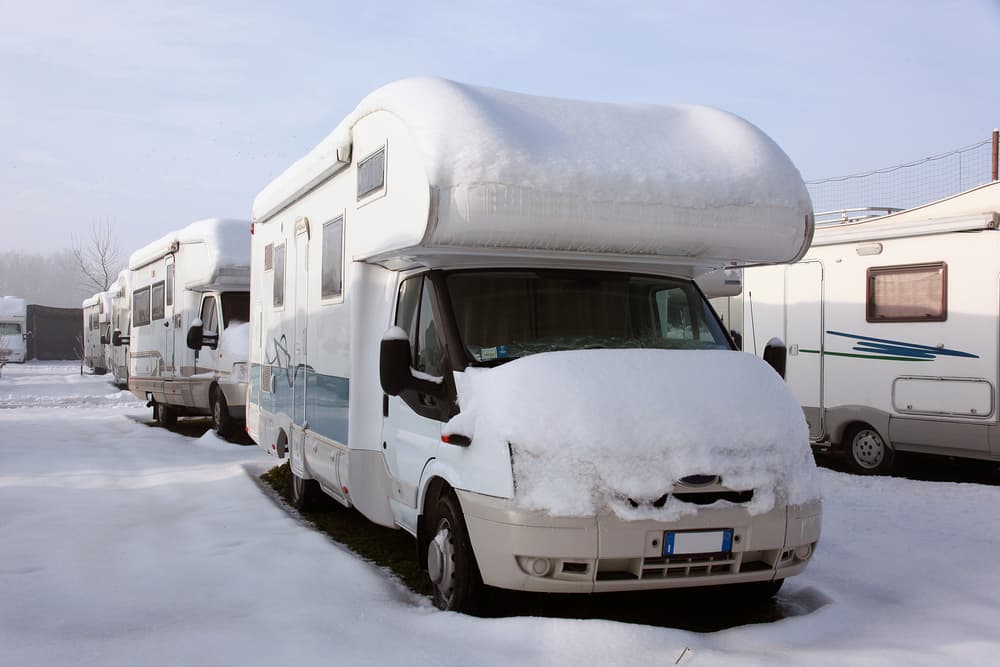While some RVers live in their RV all year long, even through a cold winter season, most choose to take a break from RVing when the winter season arrives. If you plan to store your RV for the winter, it is important to fully winterize your RV prior to temperatures dropping below freezing.
Winterizing your RV is an important step in protecting your recreational vehicle from the below freezing temperatures of winter. By properly winterizing your RV, you can ensure the plumbing, water heater, dump tanks, batteries and electronics are protected from damage when the temperatures drop. You can rest assured your RV will be in great shape for you to start RVing again when winter is over.
You should plan to winterize your RV before the first freeze of the season or whenever you quit using your RV anytime during the winter.
Here are 7 steps to winterize your RV:
- Drain the Gray and Black Water Tanks
- Drain the Fresh Water Tank and All Plumbing
- Drain the Water Heater
- Add RV-Specific Antifreeze to the Water System
- Turn Off Propane Tanks and All Appliances
- Remove Electronic Items, Cleaning Supplies, Food, Etc.
- Disconnect and Remove the RV Battery
1. Drain the Gray and Black Water Tanks
When you are done RVing and ready to winterize your RV, stop at a dumping station to make a final dump of the gray and black water tanks. You’ll want to keep your tanks empty from this point forward, so make sure you are done with all washing, showering, cleaning, or anything else that would result in water running down the drain. Plan to no longer use the bathroom once your black water tank is empty.
As you are emptying the tanks, it would also be a good time to complete a full flush of the black tank to get it as clean as possible.
2. Drain the Fresh Water Tank and All Plumbing
Disconnect the RV from any outside water source before draining the water system. Water must be completely removed from the entire water system, including the fresh water tank, the water heater, and all plumbing. If any water is left anywhere in the water system, the water will freeze and may damage part of the system when the temperatures get low.
All fresh water tanks have a drain valve at the bottom of the tank or connected to the tank through a water line. Locate and open this drain valve to allow all water in the tank to drain onto the ground. Depending on the size of the valve opening, this draining process may take 30 minutes or longer.
Drain all the water lines that run inside in the RV to the sinks, shower and toilet(s). Most RVs have a valve specifically designed for this process. Depending on the RV, there may be two valves (one for the hot water lines and one for the cold water lines). The valve(s) will be located either somewhere underneath the RV or somewhere inside the RV near the fresh water tank. Consult your RV manual to determine the location of the valve(s).
When you locate the valve(s), open it fully to allow the water in the water lines to empty onto the ground outside. You must also open all sink and shower faucets (hot and cold) to relieve the pressure in the water system and to make sure all parts of the plumbing are emptying completely.
As an extra precaution, we recommend taking the shower head off of its holder and letting the shower head hang upside down. This will make sure any water remaining in the shower head will drain out fully.
When the water lines are finished draining, close all water faucets in the RV. The faucets must be closed to complete step 4 below.
3. Drain the Water Heater
Depending on your water system configuration, much of the water in the water heater would have likely drained out when you drained the hot water lines in step 2. But you want to make sure the water heater is emptied completely.
Here is how to empty your RV’s water heater:
- Begin by turning off the water heater. Most water heaters can be operated by either electricity or propane, so be sure both power switches are turned off.
- Locate the water heater access panel on the outside of your RV and open the panel.
- You will see a number of components that are a part of running the water heater.
- Toward the bottom you will see a hexagonal bolt. For most RV water heaters, the bolt will be plastic and 1 and 1/16 inches in diameter.
- Use a socket to remove the bolt.
- The bolt will be attached to what’s called an anode rod. The anode rod is used to protect your water heater from corrosion and to extend the life of the heater.
- Pull the bolt and anode rod out so that any water remaining in the water heater tank can drain completely. The anode rod and bolt can be left off the water heater while your RV is stored for the winter.
While you have the anode rod out, inspect it to see if it needs to be replaced. If the anode rod has dissolved more than 75% then it’s time to purchase a new one.
First determine the make and model of your water heater, then search Amazon for the anode rod that fits that make and model. For example, my water heater is made by Suburban (a common water RV heater brand) and here is the anode rod I purchase on Amazon for it.
An anode rod should typically last two to three years for part-time RVers and about one year for full-time RVers.
4. Add RV-Specific Antifreeze to the Water System
Once the water system is drained, you should now add RV-specific antifreeze to protect the system from freezing. Only the RV-specific antifreeze, which is pink in color and comes in one gallon bottles, should be used. Other types of antifreeze are not safe for your RV’s plumbing.
Plan to use about 3 gallons of antifreeze for this part of the process. You can purchase the RV-specific antifreeze on Amazon or at your local Walmart.
Depending on the type of RV, there are different ways of adding antifreeze to the water system. Many RVs have a specific antifreeze inlet valve (located outside near the city water inlet) that will pump the antifreeze from the bottle into the system using the RV’s water pump. Be sure to follow the RV manufacturer’s instructions on how to add the antifreeze.
Your RV manufacturer’s instructions will also indicate how the water heater is to be bypassed before adding antifreeze, typically by turning a valve (plastic knob or lever) located either next to the water heater inside or near the antifreeze inlet valve outside.
This is a very important step because you don’t want antifreeze to be entering the water heater. If you have a built-in water filtering system, make sure you bypass that too. This may require you to disconnect the filtering system from the water system.
You are now ready to fill your water lines and faucets with antifreeze:
- Start pumping antifreeze into the water system from the first bottle of antifreeze, following your RV manufacturer’s instructions.
- You will want to keep adding antifreeze, using multiple bottles as needed, until the system is fully pressurized (the pump stops pumping).
- Starting with the sink faucet closest to the RV water pump, slowly open both the hot and cold until you see the pink antifreeze coming out of the faucet.
- Close the faucet and move on to all of the other faucets, including the shower faucet, slowly opening each one until you see antifreeze coming out.
- Continue to add antifreeze to the system along the way.
- After all faucets are done, flush the toilet until you see antifreeze entering the toilet bowl.
- Don’t forget the outside shower if you have one.
- You know you are done when antifreeze has come out of all faucets as well as into the toilet bowl.
After you have added antifreeze to the water system, pour a quart of remaining antifreeze into the toilet bowl and flush it down into the black tank. This will help protect the tank’s seal. Then, pour a cup of antifreeze into each of the sink and shower drains. This will help protect each of the drain traps under the sinks.
5. Turn Off Propane Tanks and All Appliances
Close the valve(s) of the outside propane tank(s) and turn off all inside propane switches. Make sure all appliances are turned off: water heater, refrigerator, stove/oven, dishwater (if applicable), etc. If your refrigerator has a built-in ice maker, consult the manufacturer’s instructions to learn how to winterize it.
6. Remove Electronic Items, Cleaning Supplies, Food, Etc.
Everything inside the RV that is not removed before winter starts will end up freezing. Look around every part of your RV and ask yourself “what here will freeze or be damaged when the temperatures drop below freezing?” Look through all cabinets and storage areas.
Remove the following:
- sensitive electronics such as an Apple TV, SSD stored in an RV safe, wifi routers, etc.
- small batteries from items such as smoke detectors and remote controls
- bottles with liquids, such as cleaning supplies
- all food from your refrigerator and freezer
- food in your kitchen cabinets or pantry that might become uneditable or damaged when frozen (for example, an unopened jar of spaghetti sauce will likely crack when the temperatures drop)
We also recommend removing sensitive audio/visual items such as TVs, soundbars and speakers. RVers have different opinions about whether or not to remove these kinds of items. Some choose to leave them in place for the winter. We believe it is better to be safe than sorry when it comes to expensive things like a large screen TV with sensitive electronics.
All of the items you remove should be stored in your home or (except for food) in a climate controlled storage unit.
7. Disconnect and Remove the RV Battery
Charge your RV battery fully prior to removing it from your RV. After your RV has been set in place and leveled (which requires a connected battery), disconnect and remove the RV battery and store it in a location that will stay above freezing. A fully charged battery can be stored for months without needing any kind of trickle charging.
Conclusion
After completing each of the above steps, you can rest assured your RV will remain safe and sound no matter what cold temperatures winter may bring. Even if the temperatures drop below 32 degrees fahrenheit, your RV’s water system, tanks and appliances will all be in good shape when you start using your RV again.
Related Questions
Should I Cover My RV When Storing It For The Winter?
A good quality RV cover will help protect your RV from the winter weather. Be sure to choose a cover that is the right size and fit for your RV, and that is made of a durable material that can withstand the elements. Some RVers use covers are made specifically for an RV make and model. Other RVers simply purchase a thick tarp on Amazon such as this one and then tie it down with ropes. Either option works well for helping protect your RV.

